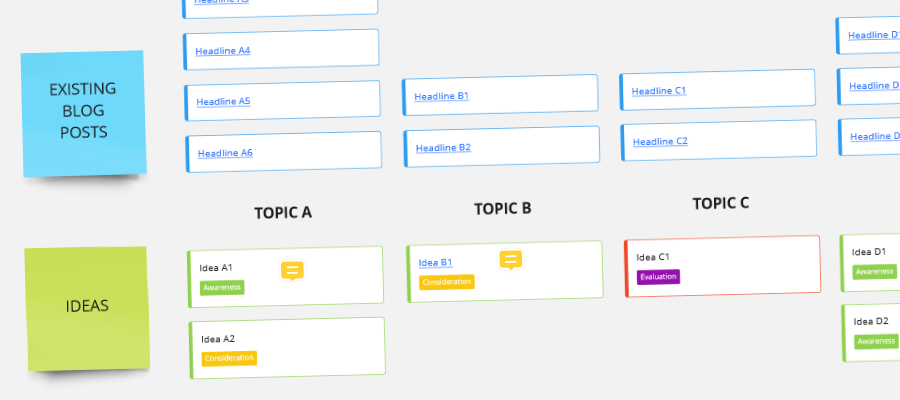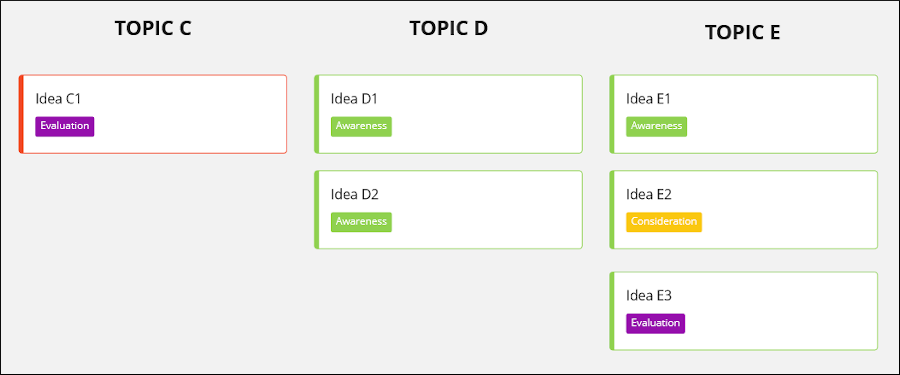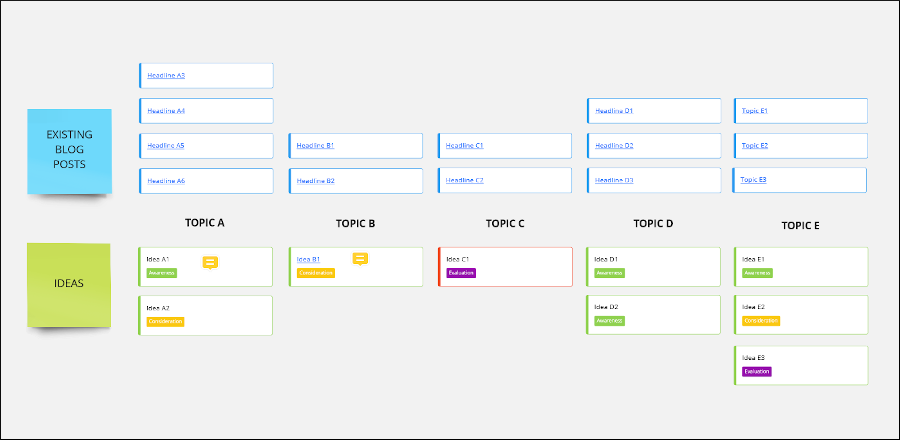
Nearly every business, regardless of its size, needs to develop and publish content to build strong relationships with customers and prospects. For best results, they must take a strategic approach to developing content. Here is a collaborative, visual way to catalog your existing blog content and identify gaps you need to fill – future topics you need to write about.
As the director of content marketing for a small B2B marketing agency, I help industrial and high-tech companies plan and implement content-focused marketing plans. That involves several steps:
- Conducting an inventory of the company’s existing content
- Understanding the key topics and customer challenges its products and services help to solve
- Developing an understanding of a typical prospect’s “buyer’s journey” – the process they follow from awareness (that they have a problem that needs to be solved) and consideration (investigating potential solutions and suppliers) to evaluation (they’re close to making a purchase decision and are asking questions to help them make it).
- Identifying additional prospect needs that haven’t been addressed by content – but should be
- Prioritizing ideas for potential implementation
- Turning the best ideas into actionable plans
I came up with this board design to give one of my clients and and I a shared visual workspace where we could identify gaps in our existing content and brainstorm new ideas to fill them.
Elements of the content gap analysis board
Here are the main elements of this workspace and how they function:
Instructions: I couldn’t assume that my client knew how to use Miro. And even if I taught him the basics, there was no guarantee that he would retain it. So I provided simple instructions that summarize how to navigate and add ideas to the board, plus a few of the conventions I use to add meaning and context to ideas (more about this below).
I also thought he might be afraid of “breaking” something. The instructions were intended to help him understand how simple Miro is to use.
Blog topics: These run horizontally across the board. For my client project, they reflected existing blog categories as well as a few new ones. Ideally, these topics should be focused on the needs, problems and aspirations of your customers and prospects. Listing them here helps to focus your brainstorming efforts, and also serve as a simple way to organize everything. Because this visual collaboration tool has an unlimited canvas, you can add new topics to the right as needed.
Existing blog posts: Classifying your company’s existing content by topic in this visual board format makes it easy to see the distribution of content across all topics. Which topics have an abundance of blog posts? Which don’t have enough? This format makes that easy to see.
Miro enables you to add links to each idea. For this purpose, they lead to each existing blog post, making it easy to refer back to them.

New blog post ideas: These appear in the lower half of the board, below the list of topics. Seeing them in close proximity to the existing ones make it easier to identify gaps – topics that you haven’t written about yet, but should.
You can also add several enhancements to these ideas to give them additional meaning and context:
- Color: The colored band and border of each idea denotes its importance. Green is normal, red denotes high value ideas.
- Tags: Each idea is tagged with colored rectangles that say awareness, consideration or evaluation. This denotes what part of the customer journey each idea addresses. Why is this important? Often, marketing teams brainstorm too many awareness ideas (basic content topics) and not enough content ideas to help prospects move through the later two stages of the buying process (consideration and evaluation). Miro’s highly visual format makes it easy to see that. One final note here: For the purpose of simplicity, I didn’t tag the existing blog posts, but you may want to. This will help you to see how your existing content is distributed along the buyer’s journey.
- Comments: Miro makes it easy to add comments to ideas. You can also enable your team to vote on ideas.
How it works
Once you have this board set up, you can invite your team members, clients or other collaborators to visit the board and contribute their ideas. As I noted earlier, you don’t need to be online at the same time to do this. Each person can login when it’s most convenient for them.
If they’re not confident about where to place their ideas within the board, just instruct them to add them in any blank space on the canvas. As the administrator, you can classify their ideas and move them to their proper locations.
Once your window for accepting new ideas is closed, you can turn your focus to discussing, improving and voting on them. Miro provides tools to support these functions.
You could even take the most promising idea, move it to a blank area of the canvas and begin working on it with your team members, exploring its feasibility, resource requirements, potential hurdles to selling it, plans to and implement it and much more.
But what if you’re not a marketer?
You can adapt this format to any type of brainstorming where you want your team to be able to see existing products, assets or other resources as they brainstorm new ideas.
Happy brainstorming!



Leave a Reply